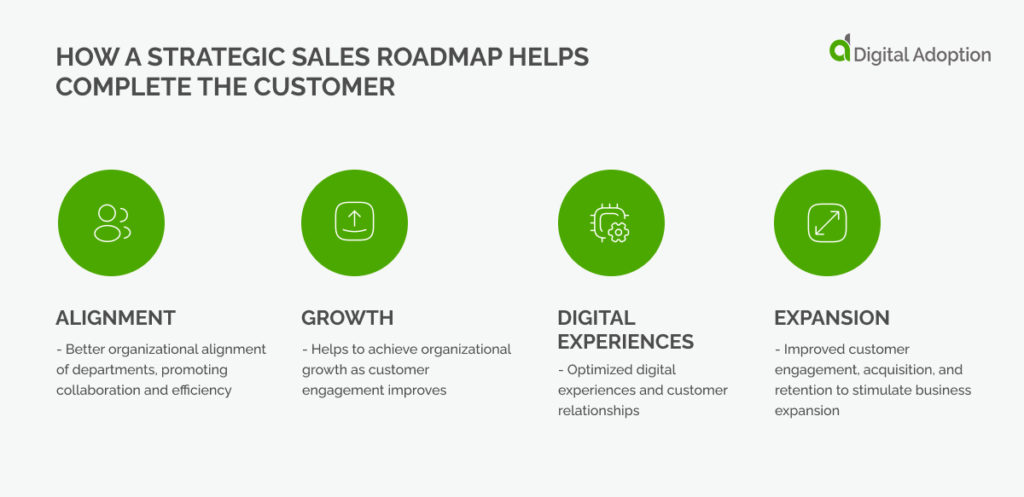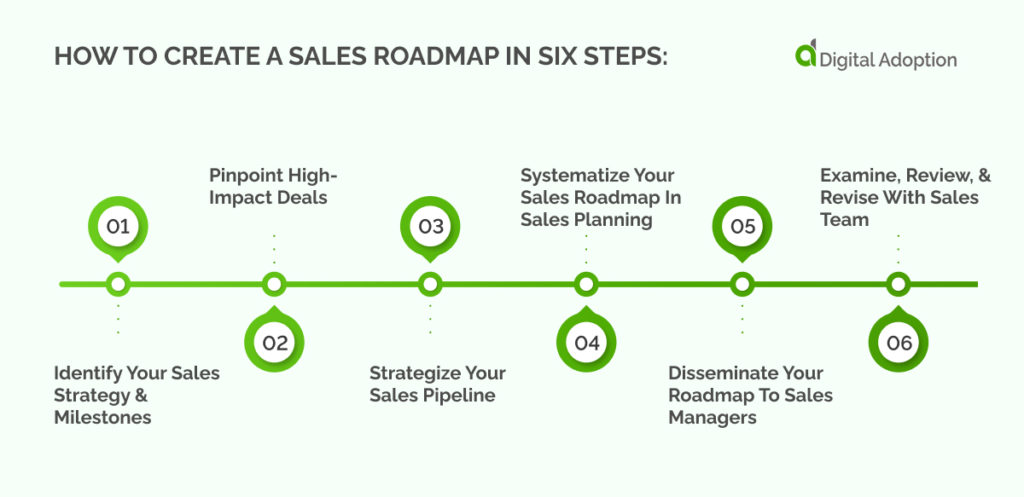Planning stands as a cornerstone of achieving success in any business endeavor. It provides a structured framework for action and serves as a yardstick for measuring the efficacy of the entire sales organization’s efforts against predefined objectives.
Across diverse functions within a business, individuals rely on meticulously crafted plans to steer them toward their respective goals. Moreover, in today’s digital age, the integration of digital adoption strategies has become increasingly vital. These strategies delineate the path toward achieving objectives by leveraging digital tools and technologies to enhance operational efficiency and effectiveness.
By embracing digital adoption strategies, businesses can optimize their processes, streamline workflows, and adapt more readily to evolving market dynamics. This symbiotic relationship between planning and digital adoption underscores the critical importance of aligning organizational goals with technological advancements to drive sustainable growth and competitiveness.
This article will explore the symbiotic relationship between planning and digital adoption strategies, elucidating how businesses can leverage these approaches to achieve their objectives efficiently and effectively.
What Is A Strategic Sales Roadmap?
But what form do plans take in sales? What are strategic sales roadmaps? And how can you create a strategic sales plan in six easy steps? We will answer all these questions, beginning with, what is a sales roadmap?
“The key is to abide by some key principles of any strategic planning process — whether at the enterprise, business-unit or functional levels,” Gartner, 2022
Definition
Strategic roadmaps help companies see their sales strategy more clearly as part of a visual plan. Strategic roadmaps do this by laying out the actions that need to occur, the time frame for each activity, and the next steps you need to complete.
Roadmaps can promote dialogues about how to approach sales strategy issues. Teams can also use roadmaps to prioritize workloads, move resources where needed and track dependencies. The sales team’s performance improvement leads to more deals.
How They Are Used
Roadmaps should always be treated as a stimulating, dynamic plan for the future, shifting and changing as views and needs transform over time. A sales roadmap zooms out to give a broad idea of the smaller and larger sales goals. Every practical sales roadmap ensures that teams are motivated, optimizing performance as they achieve every goal.
How A Strategic Sales Roadmap Helps Complete The Customer Journey & Win Customers

Gallup reports that increasing customer engagement can improve sales growth by 66%. One way to capture customer experience to build on and enhance the customer journey is by incorporating the customer journey into a sales roadmap.
When sales managers use a roadmap to capture sales goals, they can focus on specific aspects of customer experience to drive improvements to hit goals. There are many benefits to using sales roadmaps to improve the customer journey:
Alignment – Better organizational alignment of departments, promoting collaboration and efficiency
Growth – Helps to achieve organizational growth as customer engagement improves
Digital Experiences – Optimized digital experiences and customer relationships
Expansion – Improved customer engagement, acquisition, and retention to stimulate business expansion
Customer experience is a significant element of any sales roadmap, as customers drive sales, and improving their experience will always lead to higher sales figures. Following the strategic roadmap guides and supports the route to success in a structured way. There are several aspects to every roadmap.
Vital Elements Of A Sales Roadmap
Focusing on the critical elements of an effective sales roadmap ensures efficiency and a systematic approach to success.
Sales Goals
A company’s goals within a sales roadmap must always be ambitious enough to justify the investment and lead to change but also be realistic enough so that the team can achieve them. Achievable sales goals provide the deliverables to make goals clear and easy to achieve.
Midpoint Goals
Setting the company’s goals for the midpoint of a sales roadmap can also be helpful. Midpoint goals are essential to improve morale and keep staff focused on the overarching goal. Smaller goals on the way to the primary endpoint can be effective at helping staff concentrate their efforts on manageable achievements.
Major Milestones
Another way managers can ensure morale is always maintained is by setting significant milestones. When reached, these milestones can generate excitement and relief, giving staff the energy to move on to the next goal.
However, managers must also support the team and create a culture of review and acceptance that roadmaps do not always guarantee immediate success. At these points, managers must liaise with their team to re-evaluate goals. It takes much time to adjust the plan for the optimal outcome.
Action Items & Sales Tactics
Action items and sales tactics are essential tools for sales leaders to achieve organizational growth for any sales team.
Action Items
Action items are small, simple tasks that individual members of sales teams can complete. Allocating action items to sales staff has four benefits.
This technique breaks down a more significant task into smaller, more manageable tasks, creating a strong sense of ownership as the staff has their workload to complete. Action items also allow easier recording of each sales goal from the sales roadmap as the sales team completes each action item. And finally, when managers tick off each action item, there is a tangible sense of progress, improving team morale.
Sales Tactics
Team managers can use many sales tactics to track sales roadmap progress. One approach is to initiate a social media marketing campaign to improve sales. Another tactic is to prioritize inbound sales calls as hot leads. A third tactic is to offer demonstrations of a product to improve product engagement. These tactics are subject to change; if one approach is ineffective, it must be changed for a new one until outcomes improve.
How To Create A Sales Roadmap In Six Steps:

“Too many companies equate strategy with hitting financial goals. They underestimate the difficulty—and the value—of the real thing.” McKinsey, 2022
Creating an effective sales roadmap can be difficult if you don’t follow a structured number of stages. The best six steps to success are below, and it is always important to remember the final step of reviewing and revising plans with the sales team when the goal is complete. There are always aspects of a sales roadmap to improve.
1. Identify Your Sales Strategy & Milestones
Your first step must always be to identify the direction you want your sales team to head. Historical sales data and other information can help establish a detailed report of your revenue and sales goals for the upcoming year. Team managers must use this information to create milestones presented as accessible and transparent Key Performance Indicators (KPIs) for salespeople.
Milestones set at quarterly intervals can help make it easier for the entire sales organization to see their positive contribution toward progress. Specific milestones can also be practical, such as closing a significant client or nurturing individual opportunities.
2. Pinpoint High-Impact Deals
Many high-revenue or high-impact deals will strongly influence your sales roadmap’s larger goals. This point means it is essential to define precisely how the impact these factors can have to optimize them to the highest level. Such deals can involve months of refining, so make time allowances realistic.
It is essential to have specialist, high-impact salespeople in the team. This role allows team managers to know whom to refer to for information in this area.
3. Strategize Your Sales Pipeline
Sales pipelines are a vital tool in any successful sales roadmap. A sales pipeline provides the structure of points the potential client needs to go through in the sales process before the deal is closed. Sales pipelines often incorporate cold or warm emailing or calling, sales meetings, and prospecting as part of the sales process. Identifying the target market is a large part of this process.
The most crucial role of a sales pipeline is to define what a deal looks like when it is closed and what has to happen to get to this point. Sales leaders and managers can also review sales pipelines to eliminate obstacles to closing deals. If certain stages delay the deal for a target market, such as signing the contract, sales teams can invest in e-signing software.
4. Systematize Your Sales Roadmap In Sales Planning
Managers must organize sales roadmaps effectively to enable salespeople to understand them clearly. Sales leaders can also manage roadmaps using goals to satisfy stakeholders and close deals.
The key to the success of salespeople following the roadmap is that managers construct it visually and clearly. All unneeded aspects and jargon should be absent so that the smaller and larger goals are accessible and straightforward to follow from beginning to end.
Project management tools can support this task.
5. Disseminate Your Roadmap To Sales Managers
The next step is to communicate the roadmap to your team. Be open to feedback, as this is an essential part of the refinement process. Ensure the roadmap is available to all teams to encourage collaboration and cross-departmental solid alignment. When sales leaders sell the vision for the sales roadmap to the sales team, they must emphasize the ability to see the big picture of the overall objectives.
6. Examine, Review, & Revise With Sales Team
Continue to collect feedback during roadmap implementation, reducing frustration with any obstacles the sales team might experience. Any roadmap must change in form and size with the gradual changes of your business. The route to reaching objectives will change, even if the goals do not.
Following these six steps is the most effective way to ensure success with your sales roadmap. Now we will look at the complexities of implementing roadmaps most effectively.
Strategic Roadmap Approaches And Strategies

“76% percent of corporate strategy leaders say significant pivots to strategic plans now happen with increasing frequency.” Gartner
Following the six steps to produce a roadmap deals with the concrete elements of the strategy. But there are many other complexities to engage with to ensure success, such as soft skills and mechanisms to rise above unplanned occurrences such as unexpected failures that delay success.
Although the softer skills needed for strategic sales planning are more challenging due to many variables, many approaches exist to guide sales managers in this process. The first of these approaches is to create a value proposition.
Creating A Value Proposition
Creating a value proposition allows your company to show the world how it is valuable to customers. It also shows customers that your company is unique in the marketplace because of its distinctive qualities. When every staff member of a sales team accepts and advocates for the value proposition, they become proactive and engaged advocates of the sales culture.
Value propositions streamline many of the aspects of implementing a roadmap. Planning, refinement, completion, and achievement of development goals are all made much easier with an engaging value proposition plan.
The value proposition should communicate the real-world benefits your customers will acquire through your sales department and everything you can offer that no other company can.
Developing A Cross-Functional Playbook
Your cross-functional Playbook or game plan exhibits what your company is capable of (plays). These capabilities include client acquisition, account management, quality assurance strategies, systems, and tools. These are the core capabilities of the sales department.
The Playbook is similar to how it is used in football:
- Players (sales staff) study the playbook.
- Coaches (managers) use the playbook to communicate and practice the strategies used to win the game.
- When players carry out a play well, the coach rewards them.
- However, when they carry out a play poorly, the coach gives them a motivational talk and reassesses the space.
- Sometimes, the coach looks at playbook details to change plays to improve the team’s performance.
- At the end of the match (sales roadmap), the coach and players discuss what worked well from the playbook and what didn’t.
- The team continues what worked well and stops doing what didn’t work.
- Using the playbook as the primary tool, the coach has a plan with which they can execute, motivate and win.
Growth agencies which deal with high-performance organic growth are familiar with the significance of play and skill development. Growth agencies take a lot of time to develop their offensive (business development) and defensive (client retention/ client intimacy) strategies.
Sales reps focus on the frontlines of customer engagement (or the field of play), and these team members should have an opportunity to contribute to the playbook to ensure success. Tactics for some sales reps to spend more time nurturing unique opportunities can lead to closing more deals. Dialogues, where smaller teams of sales agents focus on making product roadmaps for specific product values, can also open up new clients to new services and product experiences.
Prospect Identification
The following approach involves the prospecting component, service delivery, and qualification. Prospect identification involves ways to fill the sales pipelines, criteria filler to remove “commodity shoppers,” and a way of planning that showcases your organization’s distinctive capabilities.
Global sales teams
Sales reps focus on this area more than any other member of the sales team and need to be adequately trained and briefed on how to identify prospects and their significance within the sales roadmap.
Sales reps can identify opportunities more effectively when they meet with global sales teams to discuss how different regions are approaching sales roadmaps. Sales reps can then pass this information to sales leaders to decide if the playbook for that region needs to be adjusted.
Indicators Of Success
The final approach to ensure success in any strategic sales plan is to monitor the outcomes of the sales system. Some key performance indicators are activity-based performance, sales funnel forecasting, your new hit ratio, an increase in revenue, and the quality of new business appointments. These KPIs enable sales leaders to measure the effectiveness of the roadmap and ensure the sales team achieves goals against the plan.
The quantity and quality of prospects in the sales funnel are highly significant, allowing sales leaders to see the roadmap’s effectiveness. Using initiatives, sales teams grow in learning and morale as trying new approaches is stimulating and keeps activities in the workplace fresh and vibrant in an otherwise high-stress sales department.
When these approaches are fully understood, the sales team can implement them using your roadmap to achieve success. The structure of these approaches allows you to allocate resources efficiently and deal with unintended outcomes in an agile manner. Once you have identified the best decisions, you can review these approaches’ relevant details and actions quarterly.
Key Takeaways
A strategic sales roadmap has many benefits and needs to be planned and implemented by any sales team today to improve sales figures. A practical sales roadmap zooms out from smaller tasks to give each sales team member the big picture.
The roadmap focuses on each team member, driving them to achieve organizational growth. A sales roadmap ensures that agility is always the priority, with companies able to pivot when needed to avoid loss of resources due to obstacles as sales teams grow.
The six steps of the strategic sales roadmap give a solid foundation to work with in creating a sales roadmap. But approaches and strategies are essential in filling out the details and preparing for obstacles. Using the six steps alongside the approaches and strategies improves success in any sales strategy roadmap.









